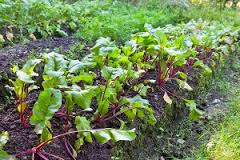
Three varieties of beets were planted last July for fall harvest in an informal field test by UC Master Gardeners of Napa County. Golden, Bull's Blood, and Cylindra were the varieties we chose for color, shape, and variety.
Twenty plants of each variety was our goal. Some participating gardeners found beets easy to grow and produced large crops. Other gardeners met some stumbling blocks from the start, including spouses mistaking seedlings for weeds, problems with germination, and at least three of our gardeners lost their entire crop to earwig damage. Marauding chickens ate some of the beet seedlings at the Master Gardener demonstration garden, and fowl were also blamed for seedling loss in some of our home gardens. Finally, in a description expressing the angst of a classic tragedy, one gardener reported waging war with gophers, only to watch her young beet plants disappear to the rodents, one by one.
There was a huge variation in total crop yields, from the low end at approximately three pounds to a high of 35 pounds. There was no marked difference in the yield among the three varieties, although Cylindra had a slight edge over the rest.
As their name suggests, Cylindra beets are long, cylinder-shaped vegetables that can be sliced into uniform sizes. Because of their shape, more beets can be planted in the same amount of space as with a typical round beet. Cylindra beets have smooth, easy to peel skin, with a bold, earthy flavor, typical of long beet cultivars. Bull's Blood beets have beautiful red tops that make a delicious addition to salads. These beets should be harvested when young for the best taste. Golden beets have a sweet flavor and they also have tasty greens. Mom wasn't wrong when she told you to eat your beets because they're good for you. Beets contain lots of vitamins and minerals, are low in calories and have 2 grams of fiber per serving.
Beets are best when grown as a cool season crop, either in the spring or late summer. Higher temperatures cause rapid growth and white rings, called zoning, in the interior of the beet. Plant your beets in an area that for a few years hasn't grown any Chenopodiaceae family members, including other beets, chard, and spinach, to avoid soil borne diseases. Beets prefer uniform loose, deep, well-drained soil. Adding organic matter to the soil is always desirable and will improve the tilth of your soil. Beets can be grown in more clay-like soil, but harvesting is more difficult and root growth may be distorted or impaired. Beets are less tolerant of soil acidity than many other crops. Lime applications can be made if you know your soil is very acid, 5.8 or below.
Beet seeds are compound, meaning that each "seed" can actually contain up to six seeds. However, this doesn't improve germination and beets are known for spotty germination, so you may want to sow moderately heavily to assure a full crop. Once the plants do germinate, you will have a lot of thinning to do. Sow seed every two or three weeks to provide a continuous harvest. Plant your beet seed two to three inches apart, in rows approximately two feet wide. Beet plants should be twelve to twenty-four inches apart. The beets we grew averaged about 60 days until harvest.
As with all crops, avoid irrigation mistakes. When growing your beets, pay special attention early in the season to avoid overwatering, especially in our drought situation. Excessive irrigation can lead to damping off and root rot disorders. Small beet seeds are unable to emerge from encrusted soil, so irrigation in this period requires frequent, light irrigation. In the rest of the season, soil shouldn't dry out. Beets develop most of their size during the second half of their growing period, so be sure they get enough water.
Like other root crops, beets store well. They should be topped, dry, and free from dirt for best storage. Either cold storage or cool-cellar storage is suitable for beets, provided the humidity is sufficient to prevent shriveling. Cellar storage temperatures should not exceed 45F degrees to prevent sprouting and decay. Store your beets in well-ventilated containers, such as slatted crates, and you'll have fresh beets for many weeks to come.
UC Master Gardeners of Napa County is recruiting for the Class of 2015! Applications are available at the last informational meeting on Tuesday, July 22, 6-7:30 p.m. at 1710 Soscol Ave.; Suite 4; Napa, CA 94559.
Master Gardeners are volunteers who help the University of California reach the gardening public with home gardening information. Napa County Master Gardeners ( http://ucanr.org/ucmgnapa/) are available to answer gardening questions in person or by phone Monday, Wednesday and Friday, 9 a.m. to Noon, at the U. C. Cooperative Extension office, 1710 Soscol Avenue, Suite 4, Napa, 707-253-4143, or from outside City of Napa toll-free at 877-279-3065. Or email your garden questions by following the guidelines on our web site. Click on Napa, then on Have Garden Questions? Find us on Facebook under UC Master Gardeners of Napa County.

